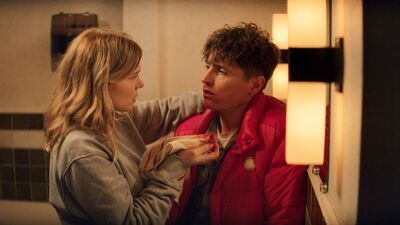A dark-minded absurdist, Dupieux (whose “Deerskin” opened the parallel festival Directors’ Fortnight five years ago) does his best to misdirect from his intentions, at least until acknowledging his authorial hand in the final image. The first significant scene consists of a lengthy dolly shot of David (Louis Garrel) and Willy (Raphaël Quenard) walking and talking. Willy can’t fathom why David, who is in the process of being pursued by a supposedly gorgeous woman, would rather hand her off to Willy. Willy makes an offensive remark, which prompts David to tell him to cut it out—because they’re being filmed.
David and Willy are actually actors making a romantic comedy, and they are soon joined by their co-stars, Florence (Léa Seydoux) and Guillaume (Vincent Lindon). Except the line between actor and character—and the line between the movie’s world and the world of the movie within the movie—is never firmly established, and the film’s central conceit is to keep the boundaries porous.
Actions that appear unscripted turn out to be scripted, until the scripted action bleeds into actual behavior. Willy’s ad-libbed, politically incorrect remarks allow Dupieux to poke fun at the perceived excesses of cancel culture while also implying that he doesn’t mean it. When Florence complains to the others that she’s “never seen anything so tiresome in her entire life,” she might as well be Seydoux, breaking character to echo the audience’s frustration at the film’s dogged commitment to repetition. Exactly where Dupieux stands in the film’s vortex of self-referentiality is worth at least a moment’s thought. The revelation of the romcom’s writer-director is by far the cleverest joke here.

If Cannes is meant to be a showcase for big, ambitious cinema, the real opening feature was Gance’s epic, which has—for American audiences, anyway—remained maddeningly difficult to come by, certainly for a film with such a high reputation. (One of my great regrets as a moviegoer is not traveling to the Bay Area to see it with a full orchestra in 2012.) Part of the trouble, as the restoration’s opening scrawl indicates, is that “Napoleon” existed in multiple cuts—and multiple negatives—right from the start; the text cites the existence of more than 20 versions over the years. This restoration from the Cinematheque Française has been talked about for what feels like forever. (I have a press release from nine years ago announcing it for 2017.) As such, it feels like a small miracle that the film was finally unveiled today—Clarisse Gance, the director’s daughter, was said to be in the theater—even if we didn’t get the famed triptych finale, which is in part two.

